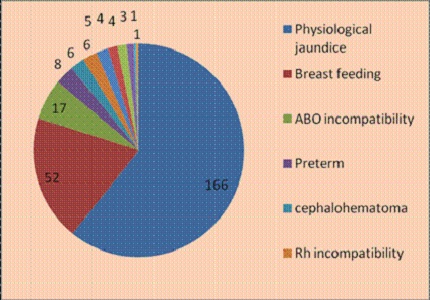Study of neonatal jaundice in a tertiary care centre of South India
Abstract
Hyperbilirubinemia is a common problem during the neonatal period occurring in up to 60% of term and 80% of preterm babies in the first week of life. Some of the most common causes of neonatal jaundice include physiological jaundice, breast feeding or non feeding jaundice, breast milk jaundice, prematurity and ABO incompatibility.
Aims and objectives of study: To study the incidence, various risk factors in newborns with clinical jaundice progressing to jaundice needing treatment and to assess no of neonates requiring phototherapy & exchange transfusion in ASRAM hospital, during May 2013 to July 2014.
Method: The present study was a prospective hospital based study involving all neonates who were born at ASRAM Medical College and Hospital, a tertiary care centre, Eluru, West Godavari District, Andhra Pradesh.
Observation: Out of 560 newborns, 273 (48.8%) newborns developed clinical jaundice. Out of 273 newborns with clinical jaundice, 166 (61%) newborns developed physiological jaundice and 107 (39%) newborns developed non physiological jaundice requiring therepeutic intervention in the form of phototherapy or exchange transfusion.
Conclusion: Present study concludes that the leading cause of pathological jaundice is breastfeeding jaundice, ABO incompatibility and prematurity.
Downloads
References
2. Haque KM, Rahman M. An unusual case of ABO-haemolytic disease of the newborn. Bangladesh Med Res Counc Bull. 2000 Aug;26(2):61-4. [PubMed]
3. Madan A, James RM, Stevenson DK. Neonatal Hyperbilirubinemia. In: Taeusch HW, Ballard RA, Gleason CA. Avery’s diseases of the new born. 8th Ed. Elsevier Saunders 2004: 1226-1256.
4. Laforgia N, Faienza MF, Rinaldi A, D'Amato G, Rinaldi G, Iolascon A. Neonatal hyperbilirubinemia and Gilbert's syndrome. J Perinat Med. 2002;30(2):166-9. [PubMed]
5. American Academy of Pediatrics Subcommittee on Hyperbilirubinemia. Management of hyperbilirubinemia in the newborn infant 35 or more weeks of gestation. Pediatrics. 2004 Jul;114(1):297-316. [PubMed]
6. Cockington RA. A guide to the use of phototherapy in the management of neonatal hyperbilirubinemia. J Pediatr. 1979 Aug;95(2):281-5. [PubMed]
7. Mary Lucia P.Gregory, Camilia R. Martin, John P. Cloherty . Neonatal Hyperbilirubinemia. In:John P. Cloherty,Eric C. Eichenwald, Anne R. Hansen, Ann R. Stark. editors. Manual of neonatal care. 7th edition, Philadelphia: Lippincott Willams and Wilkins; 2012. Chapter 26, p. 304 -339.
8. Kumar RK. Neonatal jaundice. An update for family physicians. Aust Fam Physician. 1999 Jul;28(7):679-82. [PubMed]
9. Narang A, Gathwala G, Kumar P. Neonatal jaundice: an analysis of 551 cases. Indian Pediatr. 1997 May;34(5):429-32. [PubMed]
10. Singhal PK, Singh M, Paul VK, Deorari AK, Ghorpade MG. Spectrum of neonatal hyperbilirubinemia: an analysis of 454 cases. Indian Pediatr. 1992 Mar;29(3):319-25. [PubMed]
11. Huang MJ, Kua KE, Teng HC, Tang KS, Weng HW, Huang CS. Risk factors for severe hyperbilirubinemia in neonates. Pediatr Res. 2004 Nov;56(5):682-9. Epub 2004 Aug
19. [PubMed]
12. Osborn LM, Reiff MI, Bolus R. Jaundice in the full-term neonate. Pediatrics. 1984 Apr;73(4):520-5. [PubMed]
13. Schneider AP 2nd. Breast milk jaundice in the newborn. A real entity. JAMA. 1986 Jun 20;255(23):3270-4. [PubMed]
14. Sarici SÜ, Yurdakök M, Serdar MA, et al. An early (sixth-hour) serum bilirubin measurement is useful in predicting the development of significant hyperbilirubinemia and severe ABO hemolytic disease in a selective high-risk population of newborns with ABO incompatibility. Pediatrics 2002; 100(3):600-611.
15. Chan M. Neonatal Jaundice: In Stanfield P, Brueton M, Chan M, Parkin M. (Eds) Diseases of children in the tropics and subtropics (4th Edition) London. Edward Arnold. 1994:221-8.
16. Onyearugha CN, Onyire BN, Ugboma HA. Neonatal Jaundice: Prevalence and associated factors as seen in Federal Medical Center Abakaliki, Southeast Nigeria. J Clin Med Res. 2010;3:40-45. [PubMed]
17. Porter ML, Dennis BL. Hyperbilirubinemia in the term newborn. Am Fam Physician. 2002 Feb 15;65(4):599-606. [PubMed]

Copyright (c) 2016 Author (s). Published by Siddharth Health Research and Social Welfare Society

This work is licensed under a Creative Commons Attribution 4.0 International License.


 OAI - Open Archives Initiative
OAI - Open Archives Initiative


